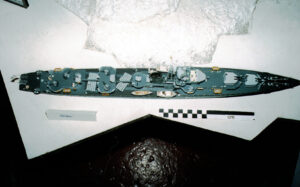The Hawthorn M Class HMS Mentor was a destroyer that served in the British Royal Navy during World War I. Built by the renowned shipbuilder Hawthorn Leslie, HMS Mentor played an active role in naval battles, including the Battle of Dogger Bank, and later in patrols across the English Channel. This article delves into the key features, design, and history of HMS Mentor, providing an overview of the ship’s service during one of the most critical periods in naval warfare.
Design and Construction of HMS Mentor
The Hawthorn M Class destroyers were designed to be faster and more powerful than their predecessors, in response to the growing naval threat from Germany. The HMS Mentor, launched in 1914, was one of the standout destroyers of its class.
- Builder: Hawthorn Leslie, a renowned shipbuilder, was responsible for constructing HMS Mentor.
- Launch Date: The ship was laid down in 1913 and launched on August 21, 1914.
- Size: HMS Mentor measured 271 feet 6 inches in length, with a beam of 27 feet. Its overall displacement was 1,198 tons when fully loaded.
- Speed: Equipped with four Yarrow boilers and Parsons steam turbines, HMS Mentor had a top speed of 35 knots (65 km/h). This made it one of the fastest destroyers at the time.
Key Features of HMS Mentor
- Armament: HMS Mentor carried three 4-inch guns, one 2-pounder anti-aircraft gun, and four 21-inch torpedo tubes.
- Propulsion: The destroyer had two shafts powered by steam turbines that produced 27,000 horsepower.
- Defense: The ship was also equipped with steel plating and designed for high maneuverability, making it both fast and reliable in battle.
Role and Service During World War I
HMS Mentor had an active service record, participating in key battles and fulfilling various patrol duties during World War I. Below are some of the ship’s main duties:

Participation in the Battle of Dogger Bank
The Battle of Dogger Bank was a major naval engagement between British and German fleets in the North Sea. HMS Mentor played a critical role in this battle.
- Battle of Dogger Bank: HMS Mentor, as part of the Harwich Force, participated in the battle on January 24, 1915. The Harwich Force’s role was to block any German attempts to retreat.
- Strategic Importance: Although primarily a scouting and fast attack vessel, Mentor’s role in Dogger Bank showed the strategic importance of M Class destroyers in fleet actions.
Patrolling Duties in the Dover Patrol
After the Dogger Bank battle, HMS Mentor was assigned to the Dover Patrol, where it played a key role in securing the English Channel.
- Channel Defense: The Dover Patrol was responsible for keeping the English Channel secure from German U-boats and surface raiders.
- Escorting Convoys: One of the main tasks of HMS Mentor was to escort merchant ships and troop transports through dangerous waters, ensuring that supplies and reinforcements could safely reach their destinations.
Impact of the M Class Destroyers
The M Class destroyers like HMS Mentor had a profound impact on naval warfare during the early 20th century.
- Technological Innovation: The introduction of faster, more heavily armed destroyers helped the British Royal Navy maintain its dominance at sea.
- Flexibility in Combat: These ships were versatile and could be used for a wide range of missions, from escort duties to direct engagement in naval battles.
Disposal of HMS Mentor
After World War I ended in 1918, HMS Mentor continued to serve the Royal Navy for a few more years.
- Post-War Service: Like many ships of its class, HMS Mentor saw limited use after the war. With the end of hostilities, the demand for such destroyers decreased.
- Sold for Scrap: In May 1921, HMS Mentor was sold for scrap, marking the end of its naval career. It had served the Royal Navy faithfully throughout the war and contributed significantly to key operations.
HMS Mentor’s Role in the Harwich Force
During the early stages of World War I, HMS Mentor was assigned to the Harwich Force, a vital fleet tasked with defending the southern portion of the North Sea and preventing German ships from accessing the English Channel.
- Harwich Force’s Objective: The Harwich Force, consisting mainly of light cruisers and destroyers like HMS Mentor, was crucial in maintaining British control over key waterways.
- Preventing German Movements: HMS Mentor and her sister ships ensured that German naval forces, particularly submarines and destroyers, could not disrupt British merchant shipping or threaten naval dominance in the region.
Battle Engagements with the Harwich Force
HMS Mentor participated in numerous smaller skirmishes and engagements while part of the Harwich Force. These battles were often fought in the narrow seas off the British coast.
- Quick Reaction Times: Due to its speed and maneuverability, HMS Mentor was often deployed to chase down and engage enemy ships quickly. This gave the Royal Navy a tactical advantage in fast-moving battles.
- Supporting Larger Ships: Although Mentor was a destroyer, it played an essential role in supporting larger battleships and cruisers during naval engagements by providing cover and attacking smaller enemy vessels.
Technological Advancements of the M Class Destroyers
The Hawthorn M Class destroyers, including HMS Mentor, were at the forefront of naval technological advancements in the early 20th century. Several key design features set them apart from previous destroyers.
- Speed and Agility: One of the most significant improvements in the M Class destroyers was their impressive top speed of 35 knots, making them faster than many other destroyers of their time.
- Armament Configuration: The combination of three 4-inch guns and four 21-inch torpedo tubes gave HMS Mentor substantial offensive capabilities, making it a serious threat to both surface ships and submarines.
- Innovative Boiler Design: The Yarrow boilers used in HMS Mentor were highly efficient, allowing the ship to maintain high speeds over long distances without sacrificing power or durability.
Conclusion
The Hawthorn M Class HMS Mentor was a remarkable destroyer that played an essential role during World War I. With its advanced design, speed, and firepower, HMS Mentor proved its worth in major naval battles and patrolling missions. Although it was eventually scrapped, its contributions to the Royal Navy’s success during the war are remembered as part of the long tradition of British naval supremacy.



